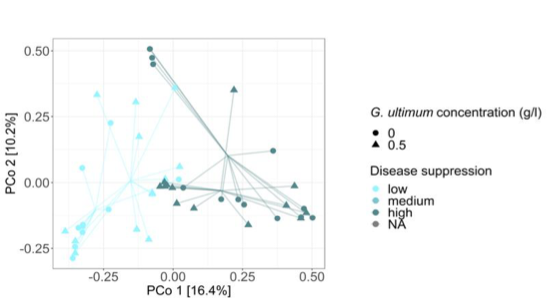Exploring the role of Pseudomonas communities in the disease suppression by composts

MSc Eva Burgunder
02/2024
Supervision: Dr. Pascale Flury
Abstract:
To meet the agricultural needs of the growing human population without compromising the environment, alternative and sustainable crop protection measures are required. Two promising options to control soil-borne pathogens, which are especially difficult to tackle with chemical pesticides, are the application of disease-suppressive composts and the inoculation with biocontrol agents. However, the efficacy of both treatments varies and is difficult to predict. Therefore, for more widespread successful application of composts and biocontrol agents, more knowledge about the taxa involved in the disease-suppressive activities of composts and the context-dependency of biocontrol agents, i.e. the circumstances under which they provide crop protection, is required. A current project, to which this Master thesis is associated, is aiming to understand disease suppression by composts and to identify the responsible microbes. In this thesis, we focused on the genus Pseudomonas and its role in the disease-suppressive abilities of composts. We made use of a recently developed rpoD-based long-read amplicon sequencing method that allows strain-specific resolution of Pseudomonas communities to investigate the context-dependency of Pseudomonas communities. We specifically sought to investigate how Pseudomonas communities differ between disease-suppressive and non- suppressive composts, the rhizoplanes of plants grown in these composts, the rhizoplanes of healthy and diseased plants, and the rhizoplanes of different plant hosts. Additionally, we aimed to develop an assay that allows the investigation of the host preferences of Pseudomonas in the laboratory.
We successfully adapted and applied the rpoD-based amplicon sequencing approach to rhizoplane samples but were unable to use the compost data because of the very low abundance of Pseudomonas in the composts. Our analysis revealed that Pseudomonas communities of cress grown in disease- suppressive composts differed significantly from those of cress grown in non-suppressive composts. We found two ASVs indicative of disease suppression that were not detected when a short-read amplicon sequencing approach was used to analyse the same samples (Mayerhofer et al., 2021), highlighting the value of long-read sequencing for identifying potential biocontrol strains. Contrary to our expectations, rhizoplane Pseudomonas communities did not differ significantly between the healthy and diseased plants. However, we found first evidence that cress and cucumber rhizoplanes harbour distinct Pseudomonas communities. During the development of a plate-based choice assay, altered swarming behaviour of Pseudomonas protegens CHA0 was observed in the presence of cucumber and Arabidopsis, but there was no indication of a preference for one plant species over another.
Taken together, our results contribute to the understanding of disease-suppressive composts and of plant-beneficial Pseudomonas communities, both promising alternative treatments for soil-borne pathogens, which can contribute to more sustainable agriculture.
Quick Links
Social Media
